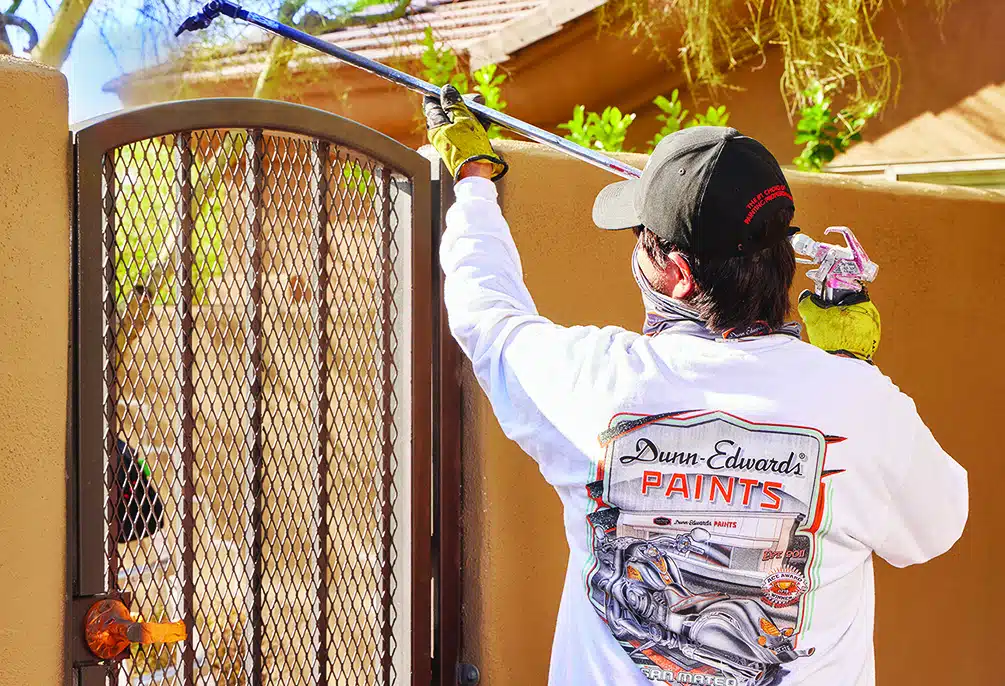About Us: Dunn-Edwards Arizona Paint Manufacturing Plant
Take a tour of our LEED® Gold Certified paint manufacturing facility in Phoenix, Arizona.
View Transcript
| Script | Transcript |
|---|---|
| Opening | [Music Playing] |
| Landscape Clip | From the hot arid deserts of Arizona, Nevada, and New Mexico to the cool, moist sea coast of California, Dunn-Edwards paints are formulated specifically for the climate of the southwest to protect and beautify a wide variety of architectural surfaces. |
| Interior/ Exterior Design Images | Since its founding 85 years ago, Dunn-Edwards has provided more than 450 million gallons of paint to the region, enough to cover more than 6,000 square miles of surface area. But why do so many professionals choose to paint their most important projects and their own homes with Dunn-Edwards paints? Because they know from experience it's the highest quality paint available. |
| Black And White Old Movie Clip | In 1925, two young wallpaper salesmen, Frank Buddy Dunn and Charles Smith, formed the Dunn-Smith Company. And by 1927, it evolved into the Consolidated Wallpaper Corporation of Los Angeles, selling wallpaper and paint. |
| Old Paper Image | By 1937, paint sales began to exceed wallpaper sales. |
| Old Factory Machinery Image | And the company opened its own paint factory consisting of two used stone mills, an agitator, a cooking kettle, and later some rotor mills. Its crew consisted of one man who made the paint and cooked the varnish. |
| Old Picture | The next year, Arthur C. Edwards bought into the business, becoming half owner. |
| Dunn-Edwards Store Image | Sales immediately improved. And a business philosophy was born- |
| Old Picture | Make the finest line of paint, and give the best service at fair prices. It's a philosophy that endures to this day. |
| 1950 Houses Clip | Throughout the 1950s, hundreds of thousands of new homes were built across California and the Southwest. Many of them were painted with the brand the professional painters recognized as the best available-- Dunn-Edwards. |
| Dunn-Edwards Stores Images | The following decade saw Dunn-Edwards continue to expand. [CAMERAS SNAPPING] |
| Dunn-Edwards Paint Cans Clip | Today, with more than 100 stores across the southwest, Dunn-Edwards remains the foremost manufacturer and supplier of premium architectural and industrial coatings in the region. |
| Landmarks Clip | With landmarks such as Staples Center Arena, Caesar's Palace, the Walt Disney Concert Hall, and many other renowned structures all entrusting their beauty to Dunn-Edwards, we understand the importance of continuing our legacy of producing the very highest quality paint possible. |
| Dunn-Edwards Distribution Center Clip | Towards that goal, in 2009, Dunn-Edwards began work on a new state-of-the-art production and distribution center in Phoenix, Arizona. The new facility includes a manufacturing plant, product development, and quality control laboratories, a distribution center, store, and office space. Totaling over 335,000 square feet, it has a capacity to produce 30 million gallons of paint annually and can employ up to 150 full time workers. |
| Karl Altergott Talking | For 85 years, Dunn-Edwards has prided itself on providing world class service and great paint. And we continue to strive towards that. Here we'll be able to expand our capacity and improve our efficiency. This new facility in Phoenix represents the next chapter in the story of Dunn-Edwards. |
| Inside Dunn Edwards Facility Clip | At the heart of the new facility is the state-of-the-art paint manufacturing plant that produces the finest paint formulations in the world. The process begins with the delivery of raw materials that include resins and various paint additives. |
| Storage Tanks Clip | Storage capacity of more than 400,000 gallons is used to store over 250 unique ingredients that are used in Dunn-Edwards diversified paint lines. Many of the liquid raw materials are stored in a 60 tank fishbowl system. Each fishbowl, which is a 275-gallon mini bulk tank stores a different additive. The weight of each tank is precisely measured using a floor scale which allows for accurate delivery of small amounts of these ingredients to a batch of paint. |
| Inside Dunn Edwards Facility Clip | [MUSIC PLAYING] One method of dry raw material addition is through our advanced slurry system which converts solid raw materials into liquid slurry that can be pumped throughout the plant. This system allows solids to be mixed 30% more efficiently. And Dunn-Edwards is the only US paint manufacturer to use this slurry technology. |
| High Speed Dispersers Clip | Dry raw materials that are not processed using the slurry system are processed using high speed dispersers. Weight controlled through load cells, these stainless steel tanks provide high speed mixing to achieve specifications. The speed and height of the mixing blades are automatically controlled and tailored for specific formulations. These high speed dispersion tanks use an integrated dust capture function so that 100% of the pigment is used in product and there are no particle emissions. This makes good sense both economically and environmentally. |
| Let Down Tanks Clip | In the final mixing steps, the end process materials and remaining ingredients are mixed in let down tanks. These tanks gently agitate up to 12,000 gallons of paint at a time to the final product specifications before the filling process begins. |
| Mark Alling Talking | To design the process control system in this plant improves the accuracy and efficiency of paint manufacturing. There over 1,600 automated valves that are used to the materials throughout the system. Every tank sits on its own load cell which can precisely weigh the amount of raw material that goes into every batch of paint. This automation ultimately saves us time, reduces waste, and helps us create a higher quality product. |
| Paint Packaging Clip | After the paint has been produced, the job of packaging and shipping begins. Dunn-Edwards automated filling lines can package over 100,000 gallons per day. It starts with the de-palletizer which automatically sorts empty cans from pallets and places them on a conveyor to be filled. As cans speed down the conveyors, they're labeled and filled. The automated fillers dispense paint into the cans based on specific formula weights to ensure accurate fill levels, cleaner fills, and lower product waist. One line alone is capable of filling 44 one-gallon containers per minute. Lids are placed on the cans, ensuring proper placement and seal. Gallon cans are baled. Each and every can is identified for manufacturing, quality control, and tracking purposes. |
| Mark Alling Talking | The processes and technology used in this paint plant are unsurpassed in the paint industry. This allows us to create a quality paint that's consistent can after can, batch after batch. |
| Paint Packaging Clip | Product is bundled in four-pack gallons and nine-pack quarts of paint. Using a strong lightweight recyclable polyethylene film, the bundler reduces packaging cost by more than 50% and eliminates the waste and energy costs associated with cardboard boxes and trays. |
| Paint Palletizing Clip | As product completes its journey, the palletizer stacks bundles of one-gallon and quart cans onto pallets. The pallet wrapper wraps the pallets with film. It uses a pre-stretched carriage that allows the film to be stretched up to 300% for optimal use and cost savings. This saves the equivalent of approximately 60 miles of unstretched film per year. |
| Paint Packaging Clip | Larger five-gallon containers go through much the same process as the gallon and quart cans. [MUSIC PLAYING] |
| Paint Palletizing Clip | One step that is different is the palletizing of the five-gallon buckets. Here, a robotic arm actually lifts and stacks the buckets. It's capable of palletizing up to 60 five-gallon buckets per minute. The robot offers a safer, quieter, and more energy efficient alternative to traditional palletizing technology. |
| Robert Wendoll Talking | This plant can be described as an ultra-low discharge facility, meaning waste generation is minimized. In addition, the entire design and construction followed LEED guidelines and has achieved LEED certification. This is all in keeping with Dunn-Edwards greener by design philosophy of being as eco-efficient as possible. |
| Dunn-Edwards Facility Clip | From the company's first paint factory in the 1930s to its industry-leading practices to develop environmentally safer formulations, Dunn-Edwards continues to set new standards of quality with the opening of this state-of-the-art eco-efficient paint factory that will pave the way into this new century. Dunn-Edwards was founded on strict standards of excellence backed by stringent quality control, testing, and eco-efficient principles to assure the finest and safest paint products possible. Our highly precise computer-controlled manufacturing process results in the best formulated, most reliable paint and coatings in the industry: |
| Paint Cans | can after can, batch after batch. No wonder Dunn-Edwards paint is the number one choice of painting and design professionals. |
| Inside Store Clip | In fact, more painting professionals paint their own home with Dunn-Edwards than any other paint. We could think of no better endorsement. |
| Closing Dunn-Edwards Logo | Dunn-Edwards-- the number one choice of painting professionals. |






